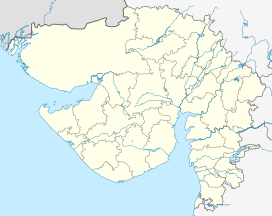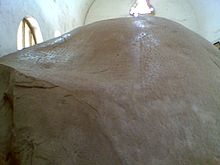Mountain Girnar
Girnar (also known as Girnar Hill or Girinagaror Revatak Pravata) is a collection of mountains in the Junagadh District ofGujarat, India, situated near Junagadh at a distance of 327 km from Ahmedabad.
Older than Himalayas,[1] Girnar, the mountain and its range are considered sacred and it's an important pilgrimage site for both Jainsand Hindus, who gather here during theGirnar Parikrama festival. Significantly famous among Shiva devotees for the mystic space-time of the mountain range with known presence and turnover of different sects ofSadhu Babas, Nath sect, different JainTirthankaras to Girnar, its typical flora and fauna, the famous Maha Shivratri fair, Girnar hosts a number of temples and some historical spots across its range. Amidst the lush green Gir Forest, the mountain range serves as the hub of religious activity.
For Hindus this place is considered holy asDattatreya stayed there. According to tradition, Pavahari Baba was first initiated into the mysteries of practical yoga on the top of mount Girnar. This mountain was considered holy to Buddhists as well.[2]
Ashoka's Major Rock Edict
Main article: Ashoka's Major Rock Edicts
Behind the west gate of Junagadh, across the bridge, is one of the most important Edicts of Ashoka. The edict is inscribed high up on a large, domed mass of black granite. The difficulty in accessing this monument allows only the few pilgrims willing to climb the mountain each year to visit the rock edict. Neatly etched on the rock surface is an inscription in Brahmi script. A much smaller replica is positioned outside the entrance of the National Museum, New Delhi.[3]
Temples of Girnar
Main temples of Girnar are
Dattatreya Paduka, a climb of 9,999 stairs.
This is a holy place for Hindus and one of the most ancient, Lord Dattatreya, performed tapa for around 12000 years on this peak.
another important temple of Mata Ambaji, at 5000 stairs.
The main annual event for Hindus is theMaha Shivaratri fair held every year on 14th day of Hindu calendar month of Magha. At least 1 million pilgrims visit the fair to participate in pooja and parikrama of Girnar hill. The procession begins at ancientBhavnath Mahadev Temple at Bhavnath. It then proceeds onwards to various akharas of various sects of sadhus, which are in Girnar hill from ancient times. The procession of sadhus and pilgrims ends again at Bhavnath temple after visiting Madhi, Malavela and Bara Devi temple. The fair begins with hoisting of fifty-two gaja long dhwaja at Bhavnath Mahadev temple. This fair is the backbone of economy of Junagadh, as more than ten lakh pilgrims, who visit the fair generate a revenue of 250 million in only five days.[4][5][6]
Hindu Temples
Paduka of Guru "Dattatreya" is situated at the top most tonk of Girnar.
Girnar have special place in the history of Hinduism, Guru Dattatreya is Adi Guru and is the combined form of Brambha Vishnu and Mahesh. Pilgrims from all parts of India and abroad come to Girnar, for Darshan. Many claim that Guru Dattatreya have given them Darshan in one or the other form. This place is most sacred for Naga Sadhus and Sanyasis.
The mention of this place is found in many puranas. Guru Dattatreya is well known Guru of Lord Parashuram. birth Lord Parashuram is prior to Lord Rama. such and many other references indicate that this Temple is very sacred and well known. the origin can be placed much before 2000 BC. Historians are the best persons to predict that.
Girnar parvat is considered to be older that Himalayas.
Amba Mata Temple : Is also one of the oldest temple.
lakhs of pilgrims specially newly weds come here for blessings.
Jain Temples
Main article: Jainism
The first peak (tunk) has beautifully carved and sculptured marble shrines; it is considered to be one of the most beautifully situated group of Jain temples in India. This group of temples is also unique in that both the Digambar and Shwetambar have temples on its hills. It has been an important religious place for Jains since the 3rd century. The Neminath Temple, built from 1128 AD to 1159 AD, is one of the main attractions. The temple complex has quadrangle courtyards, corridors and other shrines as well, with pillars adorned with intricate carvings of Jain Tirthankars. Nearby, the Mallinath Temple was built by the brothers Vastupal and Tejapala.
The golden Rishabhadev Temple, also situated in the same vicinity, is dedicated to 24 Jain Tirthankars. Another main Jain temple in the region is the ParshwanathTemple, built in the 15th century, which is also known as Meravasi.
The idol of Bhagwan Neminatha here is thought to be the oldest one in the world at approximately 84,785 years old. Interestingly, the idol predates the construction of the temple by Vastupaal and Tejpaal in the 12th century. Girnar Tirth is also called as Raivatgiri .
22nd Tirthankar, Bhagwan Neminatha has attained moksha, the liberation of soul from this place. Also, innumerable other Jain monks have attained Moksha here, making it a place of very high importance in Jain religion and one that is mentioned quite frequently in Jain books.[7]
Controversy over control of religious places. The control and status of religious places in the Girnar Mountains at Junagadh is turning out to be a bone of contention between the Jain and the Hindu community. The recent controversy involves the Neminath Temple and the Ra’Khengar Palace. While both are enlisted as historical monuments, Jains claim them as their own and say it is them who manage the two structures. Elsewhere, Hindu saints allege that the Jains have desecrated idols of Hindu gods and goddesses.
Tirthankara Neminath temple
One of the largest Jain temple is dedicated to the Bhagavân Neminath (श्रीनेमिनाथ), the 22nd Jain Tirthankar. There is an image of Neminath in each of the courtyard colonnade’s 70 cells. It was built during 1128 AD to 1159 AD.
According to Jain religious beliefs, Neminath, the 22nd Tirthankar became an ascetic after he saw the slaughter of animals for food on his wedding. He renounced all worldly pleasures and came to Mount Girnar to attain salvation. Here, Bhagwan Neminath reached the highest state of enlightenment, Keval Gyan and Moksha, after great austerities. His bride-to-be also followed his path and founded the Sadhvi Sangh, the organization of women ascetics.The rectangular Neminath temple has an idol of Lord Neminath in black granite with jeweled eyes. There are quadrangle courtyards, corridors and other shrines. The pillars are adorned with intricate carvings of Jain Tirthankars.The ceilings bear carvings and sculptures of Dancing Goddesses. It is believed the 22nd tirthankara Neminath have died on Mount Girnar after 700 years of meditation and asceticism is depicted as a black figure sitting in the lotus position holding a conch in the marble Neminath Temple.
Mallinath Temple
Girnar Mallinath Temple of Bhagavân Mallinath (श्रीमल्लिनाथ) was built by the brothers Vastupal and Tejapala who also funded temples in Mount Abu and Shatrunjaya. The idol of Baghwan Mallinath is shown in blue color.
Other Jain temples
In Girnar the Jain temples are Baghwan Rishabhadev Temple and Baghwan Parshwanath Temple. Rishabhadev Temple, situated nearby, is in golden color. Another Jain temple in the region is the Parshwanath Temple. It was built in the 15th century and is also known as Meravasi.
Five Tonks
There are 5 tonks on the Girnar hill.
First Tonk: After climb of about 2 miles, there is a Digamabar Jain temple and a cave called Rajulmati cave, it is stated that Rajulmati has done penanace and tap at this place. There is also a small temple where idol of Bhagwan Bahubali (120 cms) in standing posture is installed. Besides there are footprints of Kundkund Acharaya. In the temple, the idol of Bhagwan Neminath (Vikram 1924) is on the main Vedi. The idols of Parsvanath and Neminath are also there. There is stream called gomukhi ganga and nearby the footprints of 24 tirthanakaras are available. This is called first tonk.
Second Tonk: After 900 steps there are the footprints of Muni Anirudhhkumat and temple of Devi Ambika.
Third Tonk: here the footprints of Muni Sambukkumar are installed. Muni has attained nirvana from this place.
Fourth tonk; Here the footprints of pradhyman kumar-son of lord krishna are installed here. He attained nirvana from this place.
Fifth tonk; The Fifth tonk is of Lord Neminath's footprints. Lord Neminath, the 22nd tirthankar got moksha from this site.
Location and Transportation
The Girnar mountain is 5 km east from Junagadh city and about 400 km south west of Ahmedabad. It is easily accessible by trains and roads and state transport are also available.
Air: The Nearest airport is at Rajkot - about 100 km from Junagadh, is well connected with Ahmedabad, Mumbai, Delhi and many major Indian cities. The nearest International airport is in Ahmedabad.
Rail way: Nearest railway station is 5 km from Junagadh and easily available trains for Ahmedabad, Rajkot and other major cities.
By Road: State transport buses and private transport are available easily.













No comments:
Post a Comment